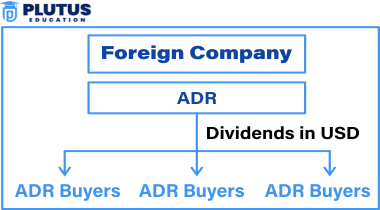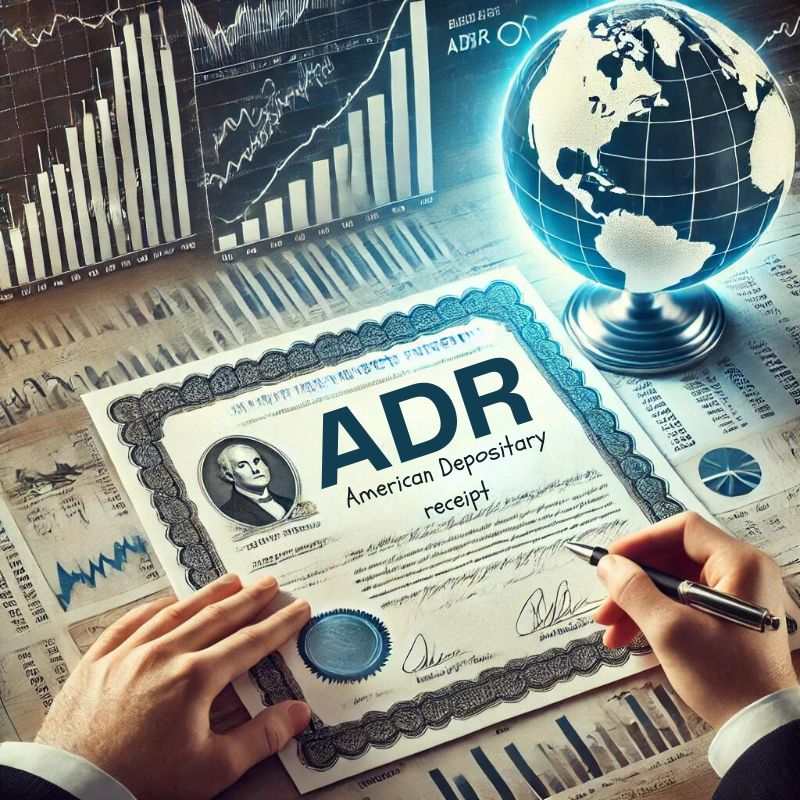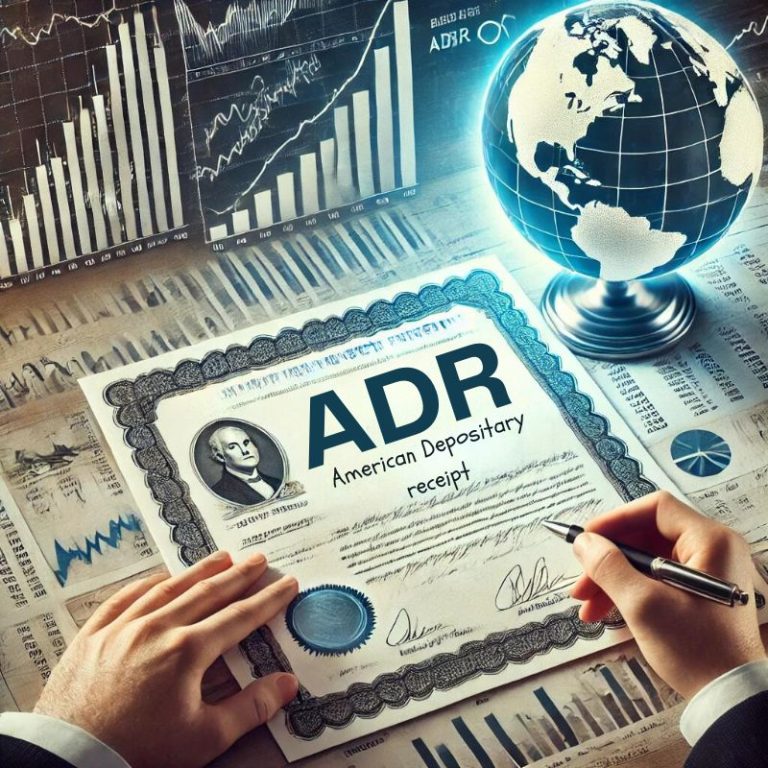An American Depositary Receipt, or ADR, refers to a negotiable financial instrument issued by a U.S. bank representing shares of a foreign company trading in the U.S. stock market. This receipt lets the U.S. investor hold foreign stocks without necessarily having to trade internationally. Since an ADR is denominated in U.S. dollars, trading foreign equities and receiving dividends becomes much easier for American investors. A U.S. bank holds the shares of the foreign company and issues ADRs, making investing easier for investors in those companies.
What are American Depositary Receipts (ADRs)?
American Depositary Receipts (ADRs) are financial tools that enable investors in the United States to purchase shares in foreign companies. The ADRs assist in ironing out some of the complexities of trading international stocks by allowing investors to purchase shares of foreign companies in the U.S. markets in dollars, making transactions involving foreign exchanges less complicated. Normally, when a foreign company wants to raise its presence in the U.S. market, a U.S. bank usually issues an ADR.
- Issued by: U.S. banks
- Currency: Denominated in U.S. dollars
- Foreign Company Stock: Represents shares in a foreign corporation

How do American Depositary Receipts (ADRs) Work?
ADRs work on a system of how a U.S. bank acquires shares of a foreign company and holds them in custody in the bank’s home country. The bank issues the ADRs based on those overseas shares to U.S. investors. The acquisition of ADRs takes place exactly like U.S. stocks-giving one exposure to overseas equities without directly investing in foreign exchange. Dividends and all capital gains will be paid in US dollars.
Process Flow:
- Purchase of Foreign Shares: The U.S. bank purchases the shares of the foreign firm.
- Issuing Company: These shares are kept in the home country of the bank, and the ADR is issued to the U.S. investor.
- Trading: It can be traded on any or all U.S. exchanges, either NASDAQ or NYSE.
- Payment of Dividend: The dividend paid in the home country of the firm is paid in U.S. dollars.
Types of American Depositary Receipts
There are three main types of ADRs, classified by the level of sponsorship and trading involvement by the foreign company.
Sponsored ADRs
In this form, the foreign company would collaborate with the U.S. depository bank in actually issuing the ADRs. Sponsored ADRs come in three levels, arranged according to their level of trading.
- Level I:
- Traded in over-the-counter (OTC) markets.
- The largest amount of complexity and quite a minimum regulatory compliance burden.
- Level II:
- Listed on major US exchanges (NYSE, NASDAQ).
- Requires much more regulatory compliance with the U.S. Securities and Exchange Commission (SEC).
- Level III:
- Permits foreign companies to raise capital by selling securities through public offerings in the United States.
- Requires full compliance with all US filing requirements and procedures.
| ADR Levels | Key Features | Compliance Requirements |
|---|---|---|
| Level I | Traded OTC, basic regulatory standards | Minimal SEC filings |
| Level II | Listed on major U.S. exchanges | Must meet U.S. stock exchange rules |
| Level III | Capital raising through U.S. IPO | Full SEC compliance |
Unsponsored ADRs
Unsponsored ADRs are not sponsored by the foreign company and therefore have no affiliation with it. In most cases, unsponsored ADRs begin with a U.S. depository bank, and multiple banks can issue ADRs from the same corporation.
Rule 144A ADRs
They are privately placed in QIBs. These ADRs are not traded on any public exchange, and their reporting requirements also tend to be more relaxed than Levels I-III.
History of American Depositary Receipts
In 1927, J.P. Morgan launched the first ADRs as a means for U.S. investors to invest in the British retailer Selfridges without having to deal with foreign currency or foreign exchange. Over time, ADRs have become one of the popular methods by which foreign companies can participate in the massive U.S. market, particularly when a country’s economy is booming globally.

ADR Fees
Fees that might not be charged on equivalent domestic stocks. To investors holding ADRs, the fees might be charged without any fee being charged on the domestic stock. This could be fees levied by a bank in charge of managing their account when holding ADRs. These fees might include:
- Custody Fees: To operate a foreign bank account, the custodian issues a charge.
- Foreign Exchange Fees: The dividends payable in foreign currency are converted to U.S. dollars.
These fees will always be included in the total amount of returns of ADR investments. Investors who own ADRs should therefore know about the fees charged on ADRs.
ADRs and Taxes
ADR investors pay U.S. taxes on any dividends and capital gains but may also be liable for taxes in the foreign company’s country of origin. In most countries, dividends are withheld and some portion is allocated for taxes, but this tax is sometimes available through tax treaties or foreign tax credits to the ADR investor.
Advantages of American Depositary Receipts
- Market Access: ADRs offer the opportunity for U.S. investors to diversify by providing access to the stock of a foreign company, without having to physically have access to foreign exchange.
- American Dollar Dividend: Dividends of foreign companies received in U.S. dollars, saving on currency conversion.
- Easy Trading: ADRs are traded exactly like any other U.S. stock and are traded on a U.S. exchange, with regulations such as those of this country.
Disadvantages of American Depositary Receipts
- Currency Risk: The receipts are in dollars, but the underlying shares are in foreign currencies. So they fluctuate with a shift in currency rates.
- Fees: Investors who invest in ADRs pay an extra fee for custody or foreign tax-handling fees.
- Regulatory Differences: Foreign companies are not all subject to U.S. corporate governance.
Conclusion
Simply put, ADRs offer an easy means for U.S. investors to penetrate international markets. Even though it makes access easier to foreign stocks, those have specific risks like currency volatility and additional fees. ADRs come in two levels: Level I, or the plain structure, and Level III with a complex structure. They cater to the different needs of investors. Despite these disadvantages, ADRs are still one of the most utilized tools to diversify portfolios across borders.
American Depositary Receipt FAQs
How do American Depositary Receipts work?
ADRs allow U.S. banks to hold foreign shares and issue receipts representing those shares to U.S. investors, making it easier for Americans to invest in foreign companies.
What are the types of ADRs?
There are sponsored and unsponsored ADRs, with sponsored ones further classified into Level I, II, and III, depending on their regulatory and capital-raising capabilities.
What fees are associated with ADRs?
ADRs may carry fees such as custody fees for holding the foreign shares, and foreign exchange fees for converting dividends to U.S. dollars.
How are ADR dividends taxed?
Dividends from ADRs are taxed in both the U.S. and the foreign country where the issuing company is located. U.S. investors can often claim foreign tax credits.
What is the main advantage of American Depositary Receipts?
ADRs simplify access to foreign stocks, allowing U.S. investors to buy shares in international companies while enjoying the protections and convenience of the U.S. financial markets.


